Want to write a product description that sells more for you (with the least amount of effort)? Learn from these product description examples.
You pop up a picture of your product, describe what it is and what it does. Bada-bing, bada-boom. Product descriptions are easy, right?
Wrong.
Product descriptions are the final frontier. The place where that target customer that you have worked so hard to nurture through Facebook ads, target audience research, email marketing, and other marketing campaigns has finally arrived on the “Buy Now” page.
Done well, a product description will get them through this final hurdle, and your product will end up in their shopping cart. Done poorly, a product description can undo all of your hard work.
So, how do you write a good product description? We looked at examples of product descriptions from the most popular, bestselling products from recent years to see what they did. Steal their secrets and watch your potential buyers convert.
Read on to discover our top 8 tips you can take from these product description examples that worked for them. We pinky promise they work!
Know your target audience.
Have you ever seen an ad and thought that perhaps the marketing team behind that ad was spying on you? They seemed to know your habits perfectly well. They knew that non-descriptive, generic examples would do nothing to sell to your overly stimulated brain that sees 10,000 ads per day. So they used specific phrases and examples that spoke straight to your VERY. OWN. SITUATION.
Crest 3D Whitestrips doesn’t just talk about mere teeth whitening. They don’t just promise pearly whites or speak to your vanity, promising beautiful smiles. They talk straight to all of those wine and coffee drinkers among you. They focus on the pain point of their specific buyer persona: that moment you look in the mirror and realize all those visits to your favorite coffee chain have taken their toll on your teeth. Then they promise to magically take all the coffee, wine, and smoking stains away. In 10 days, no less.
Talk about bold promises that solve specific buyer problems! Do the same with your product descriptions, and people will practically be clamoring to add whatever you are selling to their shopping carts.
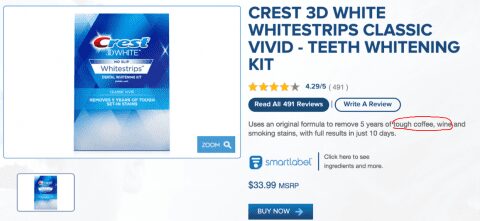

Highlight philanthropy and appeal to the buyer’s sense of community.
Corporate philanthropy is a win-win situation. Not only does your company culture benefit from the awesomeness of giving back, but your brand gets a little bump in positive vibes as well.
But there’s a catch. You have to make it obvious that you are giving back without sounding braggy or opportunistic. And you have to do it in a way that is clear as mud.
This effective product description example from Lifestraw does both just about perfectly. They could have said the tried-and-true “10% of every purchase goes to so-and-so foundation.” You MIGHT have read that and been moved. Or you would have had more questions provoked. Ten percent? How much good does that really do? What charity are they even talking about? Are they reputable? What do they DO?
Lifestraw makes the contribution crystal clear. One purchase of their Lifestraw provides one year of safe drinking water for a child. It’s that simple. And if you are on the verge of a purchase, it’s a pretty compelling reason to push “go” on a purchase decision.
If you have philanthropy built into your business model, think about ways to incorporate it into your product descriptions in a clear-cut way that doesn’t smack of manipulation. Potential buyers can smell something fishy. So keep it simple, accurate, and authentic here, folks.
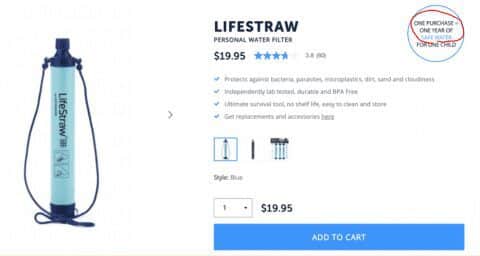

How do you describe a product to a customer? Use visuals to explain complex concepts.
When it comes to complicated products and services, it can be tempting to want to explain Every. Single. Detail.
(If your webpage has a lengthy FAQ page with subheaders that go for miles, this might apply to YOU.)
But when it comes to product descriptions, you have to distill all of that information into something simple and easy to consume. This is easier said than done. Ancestry has quite a topic to tackle. After all, what is more complicated than DNA???
Yet, they do a phenomenal job of taking a super futuristic concept and making it approachable. Instead of explaining the genetic implications of earlobes or the ins and outs of autosomes and genotypes, they give you straight and simple takeaways. Dig deeper into what makes you you. That sounds far more fun to most people than a biology lecture.
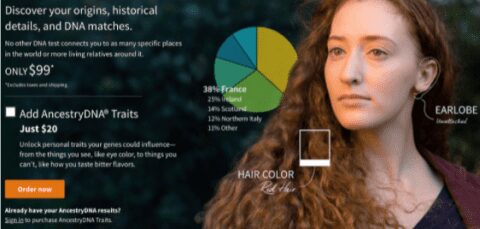

Be specific about the benefits, not just the features.
In The Wolf of Wall Street, Leonardo DiCaprio famously hands a regular ballpoint pen to a colleague and challenges him to “sell me this pen.” It has become somewhat of a marketing chant, the whole “sell me this pen” thing, with entire Reddit boards dedicated to the discussion. How, exactly, do you sell a boring old pen to just about anyone?
There are a lot of good answers out there, but they all boil down to one thing. Stop talking about the pen. Focus on how the pen benefits that person, and make them not just want that pen. Make them NEED that pen.
This persuasive product description example from Calphalon isn’t a pen, but it still illustrates the point quite nicely. While the copy spells out the product features (8 inches, nonstick, and so forth), it is in the way they illustrated how those features benefit the buyer that this copy shines. Flat, wide bottoms, why should you care? Because they help your food cook evenly and give you extra cooking room! Why are sloped sides so desirable in a pan? Because they help you toss that omelet!
Don’t just list the features of your product. Explain the product benefits and exactly why they matter in a real-life application.
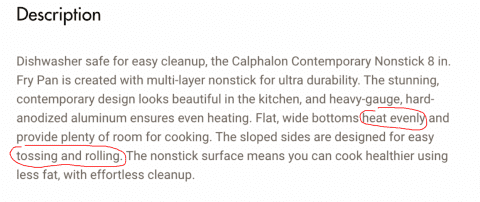

Tell them the alternative (and why your product is better).
The makers of the Rapid Egg Cooker KNOW that you don’t need their product. You already have a pot for boiling eggs, don’t you? So they tackle your objection head-on.
Cook your eggs in less time than it takes to boil water on the stove.
This is subtle but powerful. Who doesn’t like to save time?
Compelling product descriptions think about what a customer is already doing or using and tells them how a service or product feature will help them do it better.
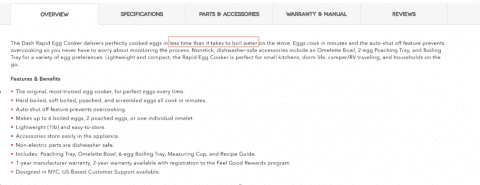

Make what they get crystal clear.
Recently, our team had a conversation about portable coolers. You know, of a beach picnic and camping variety. An ad that had popped up that promised to keep food cool just about indefinitely. How? Through solar panels integrated into its design. A few of us were even considering buying one, even with the hefty price tag of several hundred dollars. Then, a minor detail made itself more clear after a bit of digging. The solar panel, the key to the cooler’s main benefit, was sold separately.
And just like that, the shopping cart was abandoned. Why? Because in the confusion of the product description, what was and wasn’t included was unclear. And disappointed expectations always lead to problems, sometimes down the road when the product arrives.
Avoid this mistake in your product descriptions. We’re not saying you have to have endless bulleted lists, but be sure to make what your customer is and isn’t getting crystal clear within the product details. Not only will you save yourself a customer service headache, but if what you are offering is cool enough, that list of inclusions will help sell your product for you.
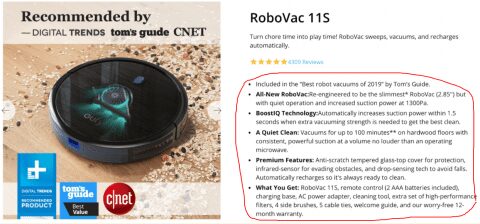

Show social proof.
Making decisions is something we have to do about 20,000 times a day. And let’s be honest, when it comes to the smaller things like cooking appliances or which brand of kitty kibble you should purchase next, you might have just run out of brainpower.
That is why it is natural for you to look to others for cues. Is this kitty kibble as healthy and delicious as so-and-so brand SAYS it is? I mean, how do they know, did they interview cats? Will this pressure cooker really cut dinner prep time in half?
Product reviews take away so many questions and objections without you as the seller having to. If you have a review system setup (which you should!), make it evident in your product description. Have services or products that are particularly popular? That’s powerful social proof! Be sure to point it out!
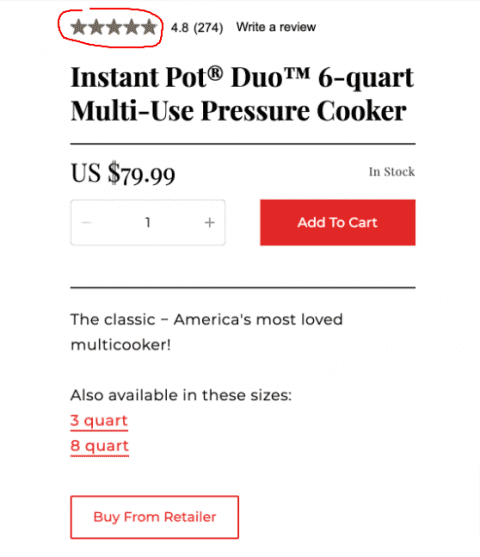

Use statistics.
People are wary of being tricked, so they get suspicious of using words like “best” or “unique” because really, what does that even mean?
But if you can give them actual numbers based on real science, that is sure to get their attention. Tied with those reviews, and you have a true force of selling power. This product description example from Nectar Memory Foam blends science and social proof perfectly.
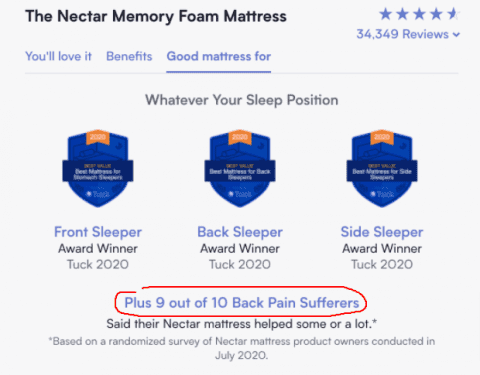

Overwhelmed by all of this? Need help?
Not sure if your product descriptions are hitting the mark? We can help you out. Schedule a call today to start a conversation about how we’ll make sure your descriptions sing and your emails are opened! You’re just one click away from your free 30 Minute consultation. Schedule a call now!

